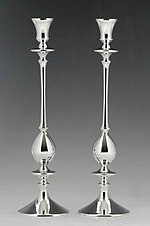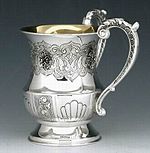Jewish ceremonial art



Jewish ceremonial art is objects used by Jews for ritual purposes. Because enhancing a mitzvah by performing it with an especially beautiful object is considered a praiseworthy way of honoring God's commandments, Judaism has a long tradition of commissioning ritual objects from craftsmen and artists.[1]
Jewish ceremonial art forms a large part of Judaica (/dʒuːˈdeɪ.ɪkə/), a general academic and art trade term for Jewish-related objects, of which other types are manuscripts, books and other printed materials, artworks in various media, and clothing.
Textual origin
Multiple early rabbinic commentaries on the Hebrew Bible refer to sanctifying rituals with visually pleasing objects in the Midrash. Midrash Mekhilta of Rabbi Ishmael has this teaching on a biblical verse:
"This is my God and I will glorify Him" (Exodus 15:2)
Is it possible for a human being to add glory to his Creator? What this really means is: I shall glorify God in the way that I perform commandments. I shall prepare a beautiful lulav, beautiful sukkah, beautiful fringes (tzitzit), and beautiful tefillin.[citation needed]
Other Midrash teachings (e.g.
Items used on Shabbat

The following items are used during Shabbat:
- Kiddush cup: Jewish holidays. Kiddush cups are highly decorated, and are generally made of china, porcelain, silver, pewter and nickel.
- Shabbat candlestick holders
- Hand washing cup ("netilat yediam")
- Challah cutting board and cover
- Havdalah candle and candle holder
- Havdalah spice box
The end of the Jewish
Hanukkah items
The
- Chanukah menorah
- Dreidels
- Gelt holder
- Chanukah candles or Oil
Sukkot items

- Esrog Box
To protect the
In modern times, the esrog is also commonly wrapped in synthetic netting, and placed in cardboard boxes. Wooden boxes are increasingly popular as well.
Books
Passover haggadah
The tradition of artistically embellished
Notable Judaica collections
Museums with notable collections of Jewish ceremonial art include the
See also
Other items
- Mizrach, object indicating the direction of prayer
- Parochet, curtain of the Torah Ark
- Shiviti, meditative text
References
- ISBN 9780810921993.
- ^ "Spice Container". The Jewish Museum. thejewishmuseum.org. Retrieved 2016-12-23.
- ^ Luminous Art: Hanukkah Menorahs of The Jewish Museum, Susan L. Braunstein, Jewish Museum, New York, 2004
- ^ Lighting the Way to Freedom: Treasured Hanukkah Menorahs of Early Israel, Aaron Ha'tell, Yaniv Ben Or, Devora Publishing (November 29, 2006)
- ISBN 9780789332516.
- ^ "Agam Brass Menorah". www.herndonfineart.com. Archived from the original on 2016-12-23. Retrieved 2009-07-30.
- ^ a b "Mending Wounds in the Judaic Collection – North Carolina Museum of Art | Untitled". Archived from the original on May 15, 2009.
- ^ "Redirecting..." www.aish.com. 26 January 2003. Archived from the original on 1 March 2020. Retrieved 4 October 2011.
{{cite web}}: Cite uses generic title (help) - ^ "Facsimile Editions - Barcelona Haggadah". www.facsimile-editions.com.
- ^ "The Barcelona Haggadah: Haggadah, liturgical poems and biblical readings for Passover, Sephardic rite". British Library.
- ^ Les Juifs et la Lorraine, un millénaire d'histoire partagée, Musée Lorrain, Nancy ; Somogy – Éditions d'Art, 2009, p. 164 ; this collection is temporarily not on public display in 2017.
- ^ "The CJM - The Contemporary Jewish Museum". www.thecjm.org.
